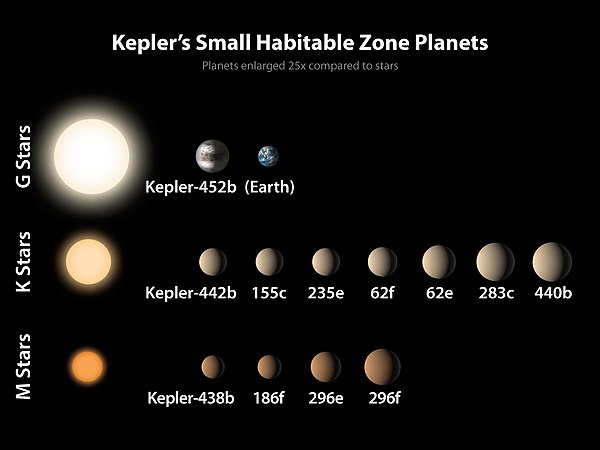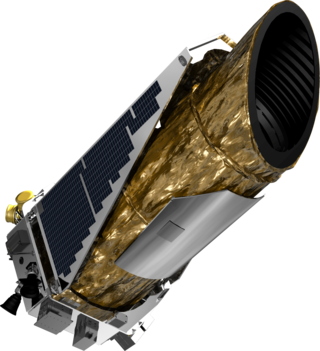
The Kepler space telescope is a defunct space telescope launched by NASA in 2009 to discover Earth-sized planets orbiting other stars. Named after astronomer Johannes Kepler, the spacecraft was launched into an Earth-trailing heliocentric orbit. The principal investigator was William J. Borucki. After nine and a half years of operation, the telescope's reaction control system fuel was depleted, and NASA announced its retirement on October 30, 2018.
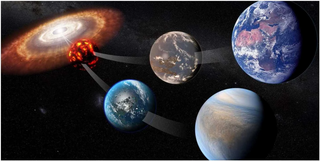
An Earth analog, also called an Earth analogue, Earth twin, or second Earth, is a planet or moon with environmental conditions similar to those found on Earth. The term Earth-like planet is also used, but this term may refer to any terrestrial planet.
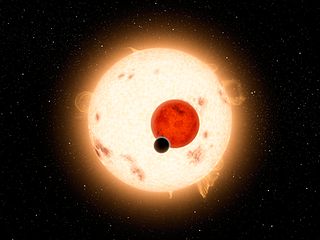
Kepler-16b is an exoplanet. It is a Saturn-mass planet consisting of half gas and half rock and ice, and it orbits a binary star, Kepler-16, with a period of 229 days. "[It] is the first confirmed, unambiguous example of a circumbinary planet – a planet orbiting not one, but two stars," said Josh Carter of the Center for Astrophysics | Harvard & Smithsonian, one of the discovery team.
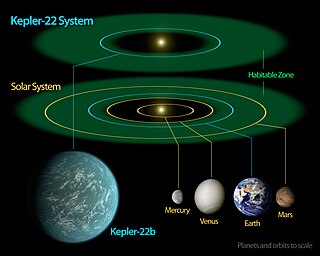
Kepler-22b is an exoplanet orbiting within the habitable zone of the Sun-like star Kepler-22. It is located about 640 light-years from Earth in the constellation of Cygnus. It was discovered by NASA's Kepler Space Telescope in December 2011 and was the first known transiting planet to orbit within the habitable zone of a Sun-like star, where liquid water could exist on the planet's surface. Kepler-22 is too dim to be seen with the naked eye.

Kepler-47c is an exoplanet orbiting the binary star system Kepler-47, the outermost of three such planets discovered by NASA's Kepler spacecraft. The system, also involving two other exoplanets, is located about 3,400 light-years away.

Kepler-69c is a confirmed super-Earth extrasolar planet, likely rocky, orbiting the Sun-like star Kepler-69, the outermore of two such planets discovered by NASA's Kepler spacecraft. It is located about 2,430 light-years from Earth.

Kepler-62e is a super-Earth exoplanet discovered orbiting within the habitable zone of Kepler-62, the second outermost of five such planets discovered by NASA's Kepler spacecraft. Kepler-62e is located about 990 light-years from Earth in the constellation of Lyra. The exoplanet was found using the transit method, in which the dimming effect that a planet causes as it crosses in front of its star is measured. Kepler-62e may be a terrestrial or ocean-covered planet; it lies in the inner part of its host star's habitable zone.

Kepler-62f is a super-Earth exoplanet orbiting within the habitable zone of the star Kepler-62, the outermost of five such planets discovered around the star by NASA's Kepler spacecraft. It is located about 980 light-years from Earth in the constellation of Lyra.
Kepler-61b is a super-Earth exoplanet orbiting within parts of the habitable zone of the K-type main-sequence star Kepler-61. It is located about 1,100 light-years from Earth in the constellation of Cygnus. It was discovered in 2013 using the transit method, in which the dimming effect that a planet causes as it crosses in front of its star is measured, by NASA's Kepler spacecraft.

Kepler-90h is an exoplanet orbiting within the habitable zone of the early G-type main sequence star Kepler-90, the outermost of eight such planets discovered by NASA's Kepler spacecraft. It is located about 2,840 light-years, from Earth in the constellation Draco. The exoplanet was found by using the transit method, in which the dimming effect that a planet causes as it crosses in front of its star is measured.
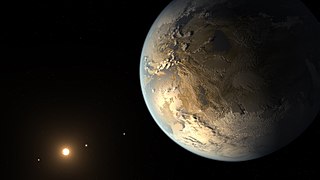
Kepler-186f is an Earth-sized exoplanet orbiting within the habitable zone of the red dwarf star Kepler-186, the outermost of five such planets discovered around the star by NASA's Kepler spacecraft. It is located about 580 light-years from Earth in the constellation of Cygnus.

Kepler-438b is a confirmed near-Earth-sized exoplanet. It is likely rocky. It orbits on the inner edge of the habitable zone of a red dwarf, Kepler-438, about 472.9 light-years from Earth in the constellation Lyra. It receives 1.4 times our solar flux. The planet was discovered by NASA's Kepler spacecraft using the transit method, in which the dimming effect that a planet causes as it crosses in front of its star is measured. NASA announced the confirmation of the exoplanet on 6 January 2015.

Kepler-442b is a confirmed near-Earth-sized exoplanet, likely rocky, orbiting within the habitable zone of the K-type main-sequence star Kepler-442, about 1,206 light-years (370 pc) from Earth in the constellation of Lyra.

Kepler-452 is a G-type main-sequence star located about 1,810 light-years away from Earth in the Cygnus constellation. Although similar in temperature to the Sun, it is 20% brighter, 3.7% more massive and 11% larger. Alongside this, the star is approximately six billion years old and possesses a high metallicity.
Kepler-419c is a super-Jupiter exoplanet orbiting within the habitable zone of the star Kepler-419, the outermost of two such planets discovered by NASA's Kepler spacecraft. It is located about 3,400 light-years from Earth in the constellation Cygnus. The exoplanet was found by using the transit timing variation method, in which the variations of transit data from an exoplanet are studied to reveal a more distant companion.

Kepler-1229b is a confirmed super-Earth exoplanet, likely rocky, orbiting within the habitable zone of the red dwarf Kepler-1229, located about 870 light years from Earth in the constellation of Cygnus. It was discovered in 2016 by the Kepler space telescope. The exoplanet was found by using the transit method, in which the dimming effect that a planet causes as it crosses in front of its star is measured.
Kepler-1229 is a red dwarf star located about 875 light-years (268 pc) away from the Earth in the constellation of Cygnus. It is known to host a super-Earth exoplanet within its habitable zone, Kepler-1229b, which was discovered in 2016.

K2-72e (also known by its EPIC designation EPIC 206209135.04), is a confirmed exoplanet, likely rocky, orbiting within the habitable zone of the red dwarf star K2-72, the outermost of four such planets discovered in the system by NASA's Kepler spacecraft on its "Second Light" mission. It is located about 217.1 light-years (66.56 parsecs, or nearly 2.0538×1015 km) away from Earth in the constellation of Aquarius. The exoplanet was found by using the transit method, in which the dimming effect that a planet causes as it crosses in front of its star is measured.

Kepler-1649c is an Earth-sized exoplanet, likely rocky, orbiting within the habitable zone of the red dwarf star Kepler-1649, the outermost planet of the planetary system discovered by Kepler’s space telescope. It is located about 301 light-years (92 pc) away from Earth, in the constellation of Cygnus.

Habitability of G V stars of G V stars systems defines the suitability for life of exoplanets belonging to yellow dwarf stars. These systems are the object of study among the scientific community because they are considered the most suitable for harboring living organisms, together with those belonging to K-type stars.



